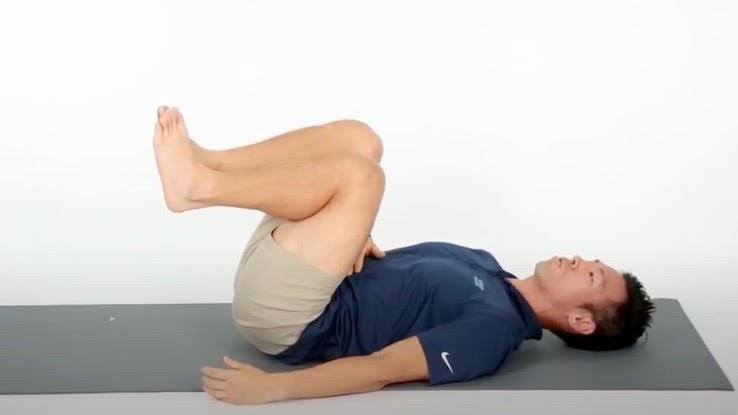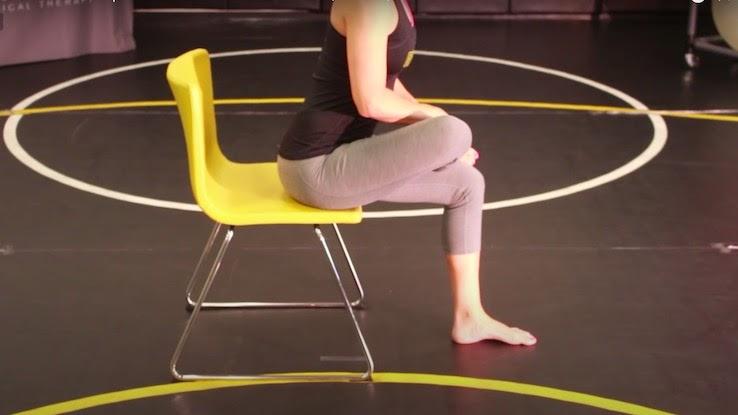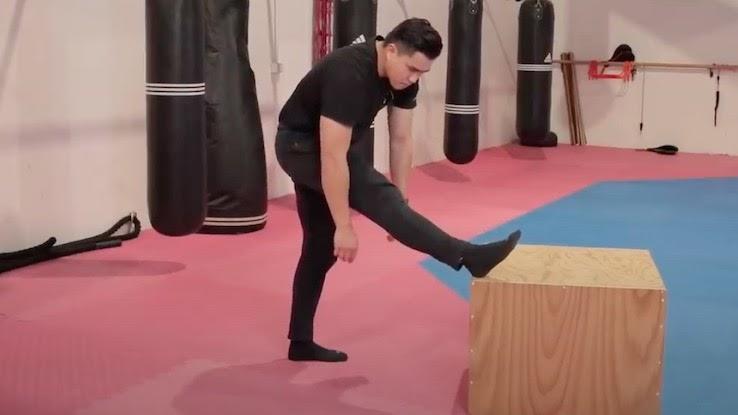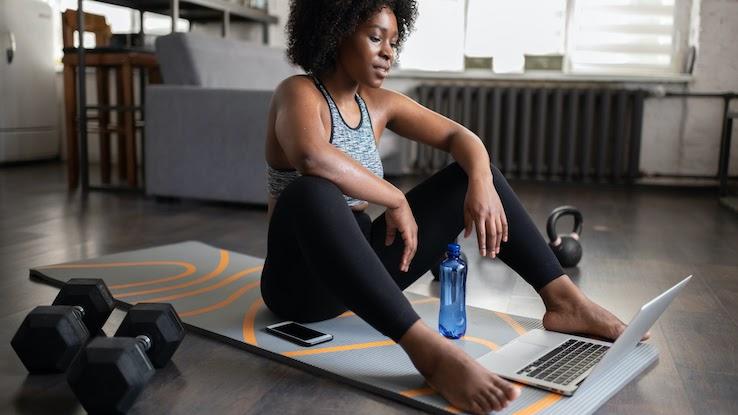9 Easy Stretches to Relieve Lower Back and Hip Pain

The sciatic nerve is the largest nerve in your body. It originates in your lower back on both sides of your spine, runs through your buttocks and hips and then branches down each leg to just below your knees. You have this nerve to thank for sensation in your outer legs and feet — and you might also have it to blame for common aches and pains.
Pain that originates in the sciatic nerve is called sciatica, and it can range from mild to quite severe. Sciatica often feels like sharp, shooting or burning pain that runs through your buttocks and down the back of one of your legs. In severe cases, sciatica can make it uncomfortable to stand, sit or even lie down. However, this nerve irritation often goes away on its own after time and with at-home treatments, notes the Cleveland Clinic. If you're experiencing painful effects of sciatica and have spoken with your doctor, some simple stretches may be all you need for pain relief.
It's common to confuse sciatic nerve pain with general back pain, but sciatica is not primarily back pain. More often, it's a literal "pain in the butt" or pain that feels like it's traveling down one of your legs. In fact, if you only feel back pain, you likely don't have sciatica. It can help to review photos of the sciatic nerve to better understand where it is in your body. Pain that aligns with these areas — anywhere from your lower back down through your leg — might be sciatica.

Generally, sciatica occurs when something rubs or puts pressure on your sciatic nerve. This can happen in several ways. The most common is a slipped disc, which happens when the soft tissue between your spine bones bulges out. Another cause is spinal stenosis, which happens when the opening narrows in your spine in the area where the nerves pass through. Additionally, a condition called spondylolisthesis, which happens when a bone in your spine slips out of position, can lead to sciatica. Risk factors of sciatica include prolonged sitting, obesity, age, diabetes and an occupation that requires a lot of heavy lifting, according to the Mayo Clinic.
If you experience sharp, burning or shooting pain in your buttocks or the backs of your legs, it may be an indication that you have sciatica. Numbness in your leg in the area where the nerve runs or a pins-and-needles sensation in your feet are other signs. If you have sciatica, you can see if it improves from a few weeks of home treatments, which consist mostly of sciatic nerve stretches and exercises. However, if you don't see improvement, if the pain gets worse or if it prevents you from doing your normal activities, it's time to see a doctor.
Several specific stretches can relieve sciatic nerve pain, though it's best to check with a doctor before you attempt them to avoid injuring yourself. Surrounding the sciatic nerve is the piriformis, a tiny muscle that helps you move your feet, upper legs and hips away from your body. Stretching out the piriformis often provides sciatic nerve pain relief.
The following stretches are common recommendations from physical therapists as home treatments for sciatic nerve pain. Doing several of these every day may improve your pain. Use photos and videos of each technique to best understand how to stretch your sciatic nerve correctly.
Knees to Chest Stretch
Begin lying flat on your back with your knees bent and your feet flat on the floor. Next, slowly bend your knees and bring them toward your chest. Hold this position for 30 seconds, and then release and relax to your initial position. Be sure to use smooth, controlled motions while you stretch to prevent strain on your back muscles.

Seated Hip Stretch
If you'd rather not get down on the floor, you can do this sciatic nerve stretch in a chair. It's also a convenient option to try while you're at work. Begin by sitting in a chair with your feet flat on the floor. Your knees should be bent at a 90-degree angle. Next, raise one leg up to rest your ankle on the opposite thigh just above the knee. Taking deep breaths, slowly bend forward over your crossed leg. Hold this position for 10 seconds before releasing and returning to the opening position. Repeat the stretch on the opposite side.

Cobra Stretch
Start by lying on your stomach with your legs extended, touching each other. Your palms should be on the floor beside your chest with your elbows bent, almost like you're about to do a pushup. For a partial cobra, push up from your palms until your arms are partially straight and your chest is off the floor at an angle of around 45 degrees. For the full cobra, fully straighten your arms so your elbows are no longer bent. Your chest will be much higher off the floor. Hold this position for five seconds before returning to the starting position. Repeat this stretch several times.

Standing Hamstring Stretch
This stretch starts you out in a standing position with your feet together. Lift one leg up and rest it on a sturdy ledge or table that's about the same height as your knees. Your stretched leg should be straight, but your knee shouldn't be completely locked. Next, bend forward at your waist, keeping your spine straight until you feel a stretch along the back of your leg. Hold here for 20 seconds and then release and return to the starting position. Repeat on the opposite leg.

Seated Spinal Twist
For this stretch, start out sitting on the floor with your legs stretched out in front of you. Bend one knee and put that foot on the outside of your other knee. Now, twist your whole body in the direction of the bent knee, placing your opposite elbow on the outside of the bent knee to push your stretch even further. Hold this stretch for 20 seconds before switching to the other side.

Preventing Future Pain
If you've had sciatic nerve pain, there's no doubt you want to keep it from coming back. Luckily, there are some ways to prevent sciatica that involve changing some of your health habits. The first is to exercise regularly. The exercise you do doesn't have to be difficult, but try to make sure you get some solid movement in almost every day.

Maintaining good posture while sitting, standing and lifting heavy objects can also help to prevent sciatic nerve pain. And, doing stretches to support your sciatic nerve consistently is another way to prevent sciatic nerve pain. Be sure to discuss new lifestyle changes with your doctor; they can make recommendations to help you stay healthy and limit your pain.
Resource Links:
https://www.mayoclinic.org/diseases-conditions/sciatica/symptoms-causes/syc-20377435
https://my.clevelandclinic.org/health/diseases/12792-sciatica
https://medlineplus.gov/sciatica.html
https://orthoinfo.aaos.org/en/diseases–conditions/spondylolysis-and-spondylolisthesis/
https://www.mayoclinic.org/diseases-conditions/herniated-disk/symptoms-causes/syc-20354095
https://www.mayoclinic.org/diseases-conditions/sciatica/symptoms-causes/syc-20377435?p=1
Source: https://www.symptomfind.com/healthy-living/relieve-sciatic-nerve-pain-simple-stretches?utm_content=params%3Ao%3D740013%26ad%3DdirN%26qo%3DserpIndex&ueid=b9135d20-52fa-4f5f-8cab-63dd7f9a31ec
0 Response to "9 Easy Stretches to Relieve Lower Back and Hip Pain"
Post a Comment